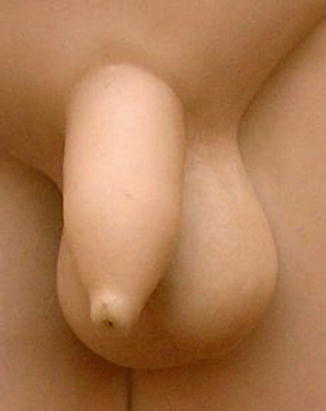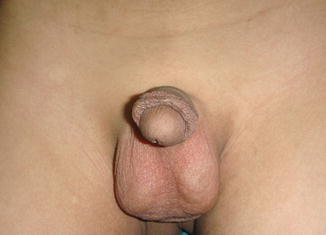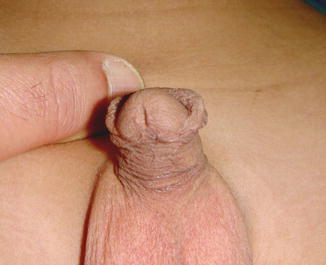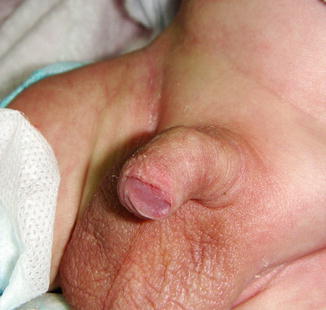(1)
Al Agouza, Cairo, PO, Egypt
Nomenclature (Fig. 3.1)
Prepuce from Latin prae, in front, and putium, penis


Fig. 3.1
Normal prepuce covering the glans completely
Foreskin, preputium, and acroposthion
3.1 Development and Function of the Prepuce
Prenatally
Almost all mammal penises have foreskins, although in nonhuman cases the foreskin is usually a sheath into which the whole penis is retracted. Only monotremes (the platypus and the echidna) lack foreskins in human. The prepuce firstly appears at 8 weeks’ gestation as a ridge of thickened epithelium; the prepuce grows forward over the developing glans so that preputial construction is complete by 16 weeks’ gestation. At this stage, however, the epithelia lining the prepuce and surfacing the glans are contiguous, with no plane of separation between them, so that “preputial adhesions” represent a feature of normal development, not a pathological process; spontaneous separation, commencing late in gestation and usually proceeding proximally, occurs by desquamation, with areas of cell nests degenerating to form a series of spaces that ultimately enlarge and coalesce to form a continuous preputial sac.
Postnatally
Preputial separation after birth proceeds at a rate varying from one individual to another and is uninfluenced by environmental or genetic factors: even at 5 years of age, some degree of preputial adherence persists upward of 70 % of boys; the process may be accompanied by mild inflammatory reaction. These episodes are possibly due to infection of retained smegma. At birth the prepuce is almost always nonretractable and usually remains so for a variable period thereafter, during which time attempted retraction results in the appearance of a blanched and apparently constricting ring of skin proximal to the preputial meatus.
Viewed end on, the preputial orifice is supple and unscarred, with an opening likened to a flower as the foreskin is pulled back.
Although normal, developmental nonretractility of the foreskin is often termed “phimosis” (means “muzzling” in Greek). This is misleading as it implies the existence of pathology when in reality there is none. “Nonretractile foreskin” and “physiological phimosis” are thus more appropriate terms.
The length of the prepuce in the human population varies from large to problematic to very small (unable to circumcise) or absent, i.e., aposthia.
Recently, Radojicic and Perovic [1] found six various morphological forms of the prepuce indicating its quantitative nature—“monk’s hood,” “cobra eyes,” “normal” (intact), “flat,” “v-shaped,” and “collar-scarf.” So the length of the prepuce in the human population varies from large problematic to very small (unable to circumcise) or absent, i.e., aposthia.
3.2 Preputial Function
The special value accorded to the prepuce in Greek culture is mirrored in the medical literature, where Galen (ca. 129–210 CE) singles it out as being among the most brilliantly useful adornments of the body. Although the prepuce serves no essential physiological function, it is not wholly without purpose. In the first instance, the foreskin typically remains nonretractable prior to toilet training, thereby—perhaps coincidentally, perhaps not—protecting the glans penis and its meatus from ammoniacal inflammation and hence meatal ulceration or subsequent stenosis.
The other consideration is that of sexual satisfaction. In contrast to the glans, which is innervated principally by free nerve endings mediating poorly localized sensations, the prepuce has a rich somatosensory innervation forming an important component of the normal complement of penile erogenous tissue. In a hypospadiac patient, the prepuce may present in several variations. In the majority of patients, the prepuce is longer than normal dorsally but absent ventrally. There are two lateral edges that are fixed at the lateral borders of the ventral aspect of the prepuce. Thus, the prepuce is deficient ventrally.
3.3 Aposthia
Nomenclature
Natural circumcision
Definition
Aposthia is a rare congenital condition in humans, in which the foreskin of the penis is missing in a normally developed penis and urethra.
Historical Background
Religious literature from various sources reflects the history of aposthia; this condition was first referenced in Jewish law of 1567 CE, in relation to a child born circumcised. Toward the end of the nineteenth century, E. S. Talbot claimed in Medicine that aposthia among Jews was evidence for the now-discredited Lamarckian theory of evolution. It is likely that the cases he described were actually hypospadias. The Midrash of Ki Tetzei notes that Moses was born aposthic. Other sources tell us that Jacob and David were also born aposthic. Jewish law requires males born without a foreskin or who lost their foreskin through means other than a formal circumcision ceremony to have a drop of blood let from the penis at the point where the foreskin would have been attached. Later on, the Prophet Muhammad was said to have been born with “natural circumcision” (in Ibn Sad Tabaqatul-Kubara). However, certain studies have reported that the trait aposthia with normal development of the urethra and glans is very rare because it is generally accepted that normal preputial development is required for the successful canalization of the glans urethra.
Incidence
It is a very rare congenital anomaly; however, in the last few years, various cases of aposthia had been reported [2]. Amin et al. [3] reported aposthia inheritance as normal quantitative recessive human genetic trait in three strictly endogamous families. Aposthia being a quantitative recessive trait may be prevalent in certain ancient healthy and comparatively developed inbred population isolates; this condition has not been shown to have a higher frequency in Jews or Muslims. If the hypospadias surgeons are fully aware about this condition, a cumulative number of cases will be reported either in association with hypospadias or as an entire pathology (Fig. 3.2).


Fig. 3.2
Noncircumcised aposthic baby
Significance of Aposthia
It is suggested that the extensive study on aposthia may be helpful for proper understanding of the importance of circumcision and reducing the controversy in medical sciences. As a result the circumcision may have been conventionalized into a forceful social motive due to constructive and healthy attributes of aposthia-bearing tribes/leader (Figs. 3.3 and 3.4).



Fig. 3.3
Aposthia, defective prepuce seen from the dorsum of the penis in a non circumcised child

Fig. 3.4
Aposthia from the ventral aspect of the penis
The modes of inheritance of aposthia trait from male to male indicate that the expression of aposthia condition requires certain Y-linked modifier loci in addition to a number of autosomal recessive genes. It seems that aposthia and hypospadias are two independent quantitative recessive traits. But the co-inheritance of these traits stresses that the loci of both traits are closely linked and it is concluded that aposthia trait is under genetic control. No cases in females have been reported in the literature to date [4].
3.4 Microposthia
Nomenclature
Hypoposthia, peeper, which is a term that refers to the penis whose foreskin is short enough to expose some of the glans when flaccid
Definition
It is a condition of having a very small foreskin; microposthia is diagnosed if the glans penis could be seen partially in a flaccid penis.
Microposthia is not a rare condition, and it is difficult to put a sharp landmark between aposthia and microposthia; it could be considered commonly as a normal variant where the prepuce looks shorter to give the chance for the glans or the urinary meatus to be visible in a neonate without foreskin retraction, and sometimes the foreskin is mainly defective at the ventral rather than the dorsal aspect (Figs. 3.5 and 3.6). Microposthia itself is not harmful and could not be considered as a disease, but its importance came from the possibility to be associated with other congenital anomalies, where the deficient foreskin is an indicator for an underlying major genitourinary diseases, like penile rotation (Fig. 3.7), but the most common associated with microposthia is hypospadias. Very rare as in Fig. 3.6 the defective dorsal foreskin hides a urethral duplication, and also few cases of epispadias may have a defective short prepuce (Figs. 3.7 and 3.8).










